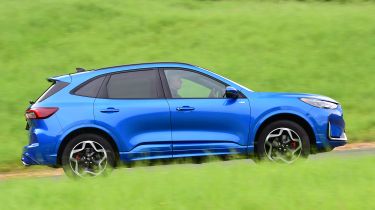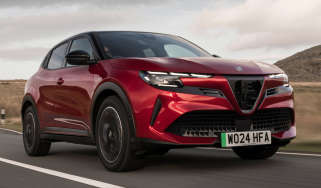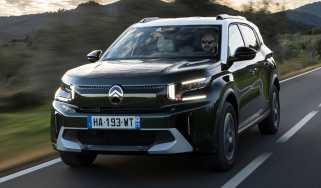Ford Kuga review - MPG, running costs & CO2
"The Ford Kuga has economical engines and maintenance costs should be very competitive"
The sole petrol engine can return up to 44.1mpg with the help of mild-hybrid hardware, so won’t be too costly to run for low-mileage drivers. Those travelling longer distances frequently will be better off opting for the self-charging hybrid as this will return up to 52.3mpg on the combined WLTP test cycle.
Provided you keep the battery topped up and drive mostly on electric power, the 2.5-litre PHEV model could offer the best economy; Ford says up to 313.9mpg is possible, but we’d recommend taking that with a pinch of salt. On longer journeys when the petrol engine will be the main power source, you’ll likely get an MPG figure in the mid-forties.
Perhaps more relevant is its claimed 42-mile electric range, as it will allow many commuters and families to complete their daily journeys without using a drop of fuel if the battery is fully charged – nearly matching the Kia Sportage with 43 miles of electric range. The PHEV will also appeal to business drivers, as its sub-50g/km CO2 emissions figure means a Benefit-in-Kind (BiK) low tax liability. VED (tax) costs the standard rate for petrol and diesel models, while the hybrids qualify for a £10 annual discount and Kugas costing over £40,000 are subject to the luxury vehicle surcharge.
More reviews
Car trim reviews
In-depth reviews
- Ford Kuga review – a sharp-handling and efficient SUV
- Ford Kuga Plug-in Hybrid SUV review
- Ford Kuga SUV (2008-2012) review
Used car reviews
A fall in sales means diesel engines were removed from the line-up in late 2021. In the Kuga there were three to choose from: a 118bhp 1.5-litre, a 148bhp 2.0-litre with mild-hybrid assistance and a 187bhp version of the 2.0-litre, which goes without the mild-hybrid tech. These can still make good buys on the used market, and the mild-hybrid engine returns up to 57.6mpg. making it popular with higher-mileage drivers. The smaller diesel offers up to 60.1mpg with the manual gearbox (53.3mpg with the automatic) and the 187bhp engine can manage up to 49.6mpg. It was the only version with four-wheel drive, so that figure isn’t too bad.
Insurance groups
Insurance groups are relatively widespread in the Kuga range, but it shouldn’t be too expensive to insure. The entry-level petrol model sits in group 16. The range moves up to the most expensive PHEV model, which is in group 26 – much lower than the Honda CR-V PHEV in group 37 out of 50.
Servicing
Ford has the largest dealer network in the UK, with a garage in most towns, and servicing doesn’t tend to be too expensive. Your dealer will be able to advise on service plans, which will cover a couple of services for an upfront fee or monthly payments.
Warranty
Like all new Ford cars, the Kuga features a three-year/60,000-mile warranty. That’s about average, but the Hyundai Tucson has a five-year warranty, the Kia Sportage and MG HS offer an impressive seven years of cover and the Toyota RAV4 has a class-leading 10-year warranty.











